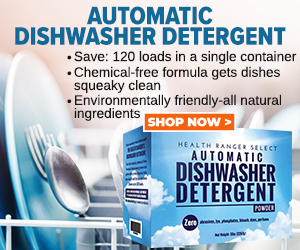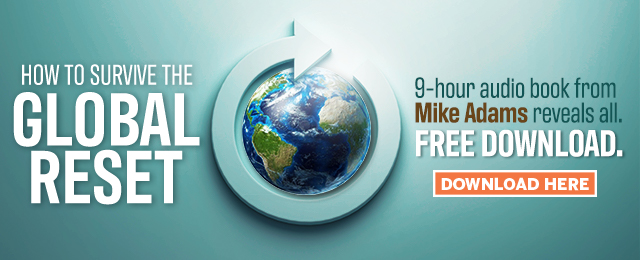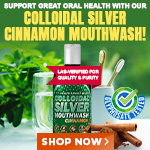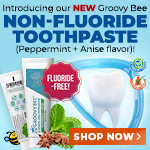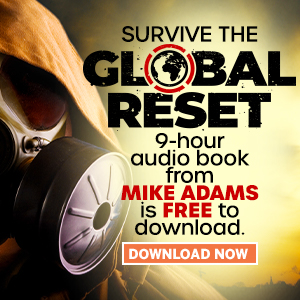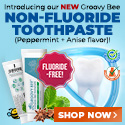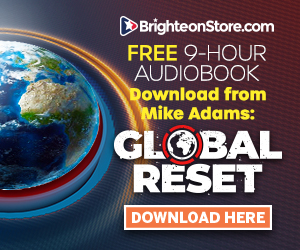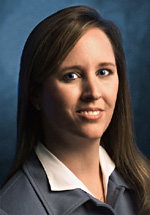
Interview with Jeanne Jennings, Online Marketing Consultant
 Monday, March 06, 2006 Monday, March 06, 2006by Mike Adams, the Health Ranger Editor of NaturalNews.com (See all articles...) Tags: email marketing, online marketing, web analytics |
- Aerosolized bioweapons? Strange “diploid biomasses” falling out of the sky in Florida captured under the microscope
- German researchers find link between mRNA vaccines and GENETIC CHANGES that precede CANCER and AUTOIMMUNE DISORDERS
- Exclusive: Microscopic analysis suggests unknown biological contaminants falling from the sky
- DEATH by 12 VACCINES SIMULTANEOUSLY: Doctor playing catch-up on jabs injects 1-year-old baby with massive combination of dirty vax cocktails
- FBI imposed gag order on agents to silence Hunter Biden laptop truth before 2020 election, new chat logs reveal
- Newly released JFK files reveal Pentagon's role in creating Lyme disease and covid in the same lab
- European Court of Justice: Healthcare professionals who promoted or administered COVID-19 vaccines are CRIMINALLY LIABLE for any harm caused
- “Project Aldrin”: Senate probes Meta's alleged censorship dealings with China
- Nature's liver guardian: Milk thistle's timeless antidote to modern toxin overload
- “Bankrupt Tesla” movement EXPOSED: Left-wing extremists, Biden-linked operatives target Elon Musk in coordinated attack
- How the Vaccine Industry escaped accountability for nearly FOUR DECADES, endangering children’s lives for false hopes of protection
- The dark legacy of the U.S. government’s UNETHICAL medical and military research
- NASA, State Dept. admit to renaming DEI programs to dodge Trump's ban in undercover sting
- When antibiotics are unavailable, natural ANTIMICROBIAL compounds become essential first line defenses against infection
- “The Message of the Sphinx”: Did a lost civilization build the Giza monuments?
- Sleep shortfalls and silent brain decline: How poor sleep patterns may herald Alzheimer's risk
- Dr. Mary Talley Bowden drops bombshells about children being permanently damaged by mRNA jabs during Tucker Carlson interview
- Astaxanthin: Nature’s ultimate antioxidant powerhouse
- Newly released JFK files reveal Pentagon's role in creating Lyme disease and covid in the same lab
- Oncologist warns of ‘terrifyingly aggressive’ cancers in children, linked to immune suppression from COVID vaccines
- Kiss Your Genetic Privacy Good-Bye! 23andMe Gets Green Light to Sell Your Intimate Genetic Details to Anyone They Want
- European Court of Justice: Healthcare professionals who promoted or administered COVID-19 vaccines are CRIMINALLY LIABLE for any harm caused
- Analysis: The coming economic collapse, a mass uprising and Trump's three secret weapons to halt the growing revolt
- Woman contracts WORLD'S DEADLIEST VIRUS after unknowingly being given the WRONG VACCINE
- Sugar-free deception: Artificial sweeteners hijack hunger signals, fuel obesity epidemic, study warns
- NIH study, buried for decades, reveals that Flu Shots INCREASE elderly deaths, not prevent them
- Britain’s descent into police state censorship: Parents raided for questioning their daughter’s school system online
- AI weather model outperforms traditional forecasts, boosts accuracy by 20%
- Aerosolized bioweapons? Strange “diploid biomasses” falling out of the sky in Florida captured under the microscope
- DARPA: The shadowy innovator behind the world’s most advanced military technologies
- The Health Ranger releases “Vaccine Zombie” song and music video, using AI-animated zombies for the music video
- Utah governor allows ban on LGBT pride flags in public buildings and schools, will take effect without his signature
- COVID-19 scandal linked to CANCER SURGE: Billionaire researcher sounds alarm
- Musk targets “strangely wealthy” lawmakers in DOGE probe, names Pelosi, McConnell, Schumer
- Dr. Suzanne Humphries makes bombshell appearance on Joe Rogan podcast, exposing vaccine industry deception back to POLIOMYELITIS
- Ancient kitchen secrets REVEALED: How garlic, ginger and green onions fight cancer and heart disease
- Newly released JFK files reveal Pentagon's role in creating Lyme disease and covid in the same lab
- California's social media censorship law struck down: A victory for free speech or a threat to online safety?
- EPA advisor admits the agency is funneling billions to climate groups ahead of Trump’s return to White House
- Dr. Mike Yeadon releases 15-minute testimony - WATCH - about genocidal intent of COVID “vaccines”
- The Health Ranger releases “Vaccine Zombie” song and music video, using AI-animated zombies for the music video
- Florida takes a stand: DeSantis proposes permanent ban on mRNA vaccine mandates
- Rep. Nancy Mace introduces bill to ban biological males from female facilities on federal property
- Mike Adams releases country western hit single: Goin’ Back in Time is Comin’ Home
- Sugarcane extract superior to cholesterol-lowering drugs?
- Survival 101: Effective EMF blocking techniques
- “Why we influenced the 2020 elections”: Facebook files reveal the coordinated effort to bury the Hunter Biden laptop story
- Unpacking the Lies That We’ve Been Fed – new song and music video released by Mike Adams, the Health Ranger
- House Intelligence Committee calls for the ARREST and PROSECUTION of Dr. Anthony Fauci
- The pandemic as a tool for INDOCTRINATION: Understanding “The Indoctrinated Brain” by Dr. Michael Nehls
- Mike Adams releases music poetry sensation: A Child of God
- OpenAI whistleblower who dissented against how the company trained ChatGPT found dead
- Attorney and TikTok influencer explains how he was offered hundreds of dollars to make false claims about Trump, Republicans
- CONSERVATIVES SOUND THE ALARM: Big Pharma and the Left trying to force $32 billion money grab from America’s seniors into year-end spending deal
- Red Cross issues warning to stop blood plasma donations from vaccinated people
- Scientists confirm: GENIUS brain function can be spontaneously unleashed in humans without any apparent cause
- EPA advisor admits the agency is funneling billions to climate groups ahead of Trump’s return to White House
- HYSSOP: What research reveals about the health benefits of this ancient holy herb
- Two containers with completed ballots fall out of truck in Florida
- Fully vaccinated about to see “tsunami” of illness and death, warns virologist
- Global leaders unite to clamp down on “misinformation” with UN-backed Cascais Declaration
- BREAKING: 2025 NDAA authorizes mandatory military draft of WOMEN across America… as Pentagon pursues global NUCLEAR war with both Russia and China at the same time
- Michael Yon warns of a ZIONIST TAKEOVER in Trump’s second administration
- Ozempic and Wegovy weight loss drugs are injectable LIZARD VENOM PEPTIDES that may unleash a devastating wave of organ failure… side effects align with symptoms of SNAKE BITES
- BOMBSHELL: DNA testing kits are a SCAM to develop ethnic-specific bioweapons
- Newly released JFK files reveal Pentagon's role in creating Lyme disease and covid in the same lab
- Israeli soldiers accused of even more torture and abuse in the West Bank
- These 13 countries just signed an agreement to engineer a global FAMINE by destroying food supply
- NASA admits that climate change occurs because of changes in Earth’s solar orbit, and NOT because of SUVs and fossil fuels
- The Health Ranger releases “Vaccine Zombie” song and music video, using AI-animated zombies for the music video
- RFK Jr. clears key hurdle: Sen. Susan Collins backs controversial HHS nominee, signaling a new era for health policy
- Sermon 30: How Jesus reveals Caesar’s FAKE CURRENCY and FALSE AUTHORITY
Jennings: I actually got into the online world back in the 1980s. When I graduated with my MBA, I was fascinated with online. I felt like there was so much information in the world, and online seemed to me to be the best way to organize and present it. I love using things like Dialog, where you can search through databases of content and find exactly what you need. I went to work for CompuServe, which, at that time, was the largest online service in the country. America Online was a blip, if it even existed. My girlfriend used to work there; she'll confirm that. CompuServe was the big guy.
I went to work in their business services division, and we helped companies like Marriott and NovaCare, which is a health care company, and the American College of Physicians basically use online communications. It was posting documents online, and it was getting information from hotels, and numbers and discussion groups. I sort of think that what we did there was the precursor website.
Mike: Sure, everything was dialog.
Jennings: Everything was dialog. Everything was text. We didn't even have GOI (Graphic Organizer Interfaces) back then; they weren't around. So yeah, it was all dialog and all text, and when you look back on it, it was pretty archaic. But at the time, it was pretty state of the art. So that's how I got into online. I spent a couple of years there and really loved it. After that, I moved into the publishing industry as it became clear the internet was going to become more of a household word and experience. It became clear that there were a lot of content companies that would pay CompuServe to have access to these online subscribers.
Well, the Internet really flipped that model. All of a sudden, it became very clear that on the internet, the world wide web, content companies would be the ones who would be king. That's when I jumped ship and went into the publishing industry and helped a couple of different publishers. Congressional Quarterly was the first company I went to. The last company I went to was Reed Business Information, a subsidiary of Reed Elsevier. I helped them put their content online and use online more effectively to deliver their content.
Mike: At what point did you get involved with email newsletters?
Jennings: I did my first one at Congressional Quarterly, which would have been about 1995-96. I'd be embarrassed to show it to you today. I'm sure it was really awful. Back then we didn't really know. We made it up as we went. Then, I continued to dabble in email, and I really focused on email in August of 2000, when I was hired by Reed Business Information U.S., which then was called Commerce, to be the director of email product development. That's when I really started doing nothing but email.
Mike: When did you launch The Jennings Report?
Jennings: I launched The Jennings Report shortly after I went out on my own, in the early part of 2002.
Mike: Now, what do you focus on in The Jennings Report?
Jennings: The Jennings Report came out of an interesting situation. I'm sort of an information sponge. I read everything I can. So I was, as we all were, reading everything I could about email. Actually, I had been for years, and I would have people call me -- colleagues and people I know -- saying, "Hey I know you read a lot. Have you ever seen anything like this?" I could usually point them to something. I got to the point where I said, "Why don't I do a newsletter that sort of has the best of the stuff I've seen on the Internet pertaining to email marketing?" It was sort of twofold. For one, I thought this would give me a really organized resource to use to use to develop an archive. Also, it would give other people a resource to use. Obviously, I'm not the only person looking for this stuff. That was really how it started. So when I am on the internet, doing research for clients and myself, I take note of things that I find interesting. I like things that have statistics in them and benchmarks. I like research on the industry and what's happening. I also look at case studies. I'm a real kind of nuts and bolts girl. I like the big picture articles. I think they're fun. But I really love articles that give me practical things that I can try right now, today.
Mike: So can you talk about a couple of those things that you've covered in recent issues in the newsletter? Nuts-and-bolts issues?
Jennings: Sure. I always write a publishers note in addition to an article. I had been at a couple conferences, and at two different conferences, two different email companies introduced a partnership with web analytics companies, whereby they're working together, and if you are using their email service and you sign up for this, you can track the recipient's stream from the email all the way through the website.
Mike: That's interesting.
Jennings: It's fascinating. You can do a couple of things. You can actually see how they are similar and different for people who get to your website other ways. You also can see, if you're sending out an email -- which many of my clients are doing to drive people back to a site or to take a specific action -- you can actually see if they accomplished that action, not just if you got them back to that site. It's nice because it's all integrated.
Mike: Web analytics is a hot topic today to begin with, even without considering email.
Jennings: Yes, and I have dealt with web analytic programs for years. A lot of the work I do involves websites and helping people optimize the sign-up for their email, getting more people in to grow their lists. I've used analytic reports for years to figure out where we're losing people and stuff like that, and how we're doing on converting. The new programs have these beautiful interfaces that make it so much more user friendly. Then you add in the email component, and to me it's breathtaking to see it all.
Mike: Have you been able to initiate some large campaigns and see the results of that all the way through with web analytics?
Jennings: That's the idea. The two companies were just introducing these products. I've seen the demos, and I've played with them a little, but I haven't done anything with clients yet. That's sort of a new thing that I'm really excited about. Like I said, independently, these two companies came up with this, and I think we're going to see everyone start doing this.
Mike: Isn't there an issue of actually being able to track those users? Aren't they tracked with an image bug, and now the newer Outlook Express won't even open those images?
Jennings: It's an issue. It's something we are all aware of, and everyone is really concerned about, because a lot of the new programs, in an effort to stop spam and phishing, are making any links not live. if you get an HTML email this kills you, because you can't click on it, and if there is no URL visible you can't type it in, and then the images don't show up. So it's something we're really concerned about. We've made some changes to my clients' emails, probably the biggest of which is that we no longer make headlines as graphic images, because the idea is, if the graphic doesn't show up, they won't be able to read the headlines. We're focusing much more on using the graphics. We always tried to use them sparingly and where they make sense. We wanted to be sure the message would still be understood if the graphic weren't there. It's a problem. It affects the whole click-stream tracking that I've already spoken of. The thing about it is, as concerned as we all are, I haven't seen or heard of anyone having any huge repercussions from it as of yet.
Mike: I've heard that it has really started skewing the open rates, because, obviously, a lot of people are opening emails that are not being reported back to the system.
Jennings: It could do that, but I haven't seen that yet. But it definitely has the potential to do that. The other thing that we've been doing with my clients is including a little note at the top that says, "Please take a minute and put our return address in your address book. This might help white list us." With a lot of programs, if the sender is in the address book, they won't block the images or the links. That's one piece of insurance we've been working on.
Mike: It's an interesting piece of strategy too, one-to-one white listing.
Jennings: Exactly. That's the other thing about all this. It doesn't work with every spam filter, but it does work with some. It is a moving target. I'm hoping that, as things come into play, they will help control the spam issues, and some of these other things will be relaxed.
Mike: Let's talk about spam for a minute. Unfortunately, we've seen recently that the Sender ID conversations have broken down. The big guys out there at AOL and MSN can't seem to get along and agree on an anti-spam standards. What do you think will play out with this?
Jennings: I think we'll come to a standard. I actually spoke to AOL and MSN at a conference in Chicago, and I think we're going to come around. Everyone really wants the same thing in the end. While they're advocating different ways to get there, I don't think they're as far apart as we are necessarily led to believe in the press.
Mike: I hope you're right.
Jennings: I hope I'm right, too.
Mike: We all need it in the industry.
Jennings: Yes, we all need it.
Mike: It seems there is always somebody in there trying to claim the intellectual property for some solution. It has to be open source if it's going to work, right?
Jennings: It seems like it. It's funny, my husband's an intellectual property attorney, and so I understand why they want their IP rights. But at the end -- and this is the impression I got from the folks at AOL and MSN -- what we all really want is a solution. I think there is going to be a little bit of negotiating back and forth, but I do think we are going to get there. We have to. Everyone pretty much agrees.
Mike: Yes, it seems like if we don't, then the medium is going to continue to be polluted, and that really hurts everybody in the industry -- especially those who are trying to market with ethics and professionalism.
Jennings: Yes, I was at another conference, and one of the speakers asked a very good question. He asked everyone in the room to hold up a hand and then lean it this way or that to show where they stand on this issue. One side, to the far left, meant "I'll do anything it takes to get my email out and make money with email, and I don't care if it pisses people off." The other side of the spectrum was, "I'm going to be really careful. I do want to make money with email marketing, but I want to do it without upsetting anyone and without violating any legal or integrity issues. I really want to do it right, and I believe I can do it right." He asked people to hold up where they stand. His point was that if you're not more toward the integrity, you're doing long-term damage to this medium. You could be killing the goose that laid the golden egg. The work I do with my clients has always been "opt in." Ever since I started, I've always been a proponent for opt in, and I continue to be, even though it's not the law now.
Mike: I find it interesting that it's not yet really the law, even the CAN-SPAM Act didn't really outlaw spam.
Jennings: No. It's really frustrating, and the way I've come to terms with it is, I think it was a good first step considering we had nothing before, but I ... like I said, I get calls all the time from people saying, "Look, I only do opt in. I know it's not illegal if it's not opt in. I just don't want to do it. I just don't agree with it, and I don't think it works as well. That's not how I want to use this medium." So, I know other people who feel the same way that I do. I think there are a lot of email marketers out there using it in very legitimate ways, with lots of integrity, and my hope is that that's what we will have left standing at the end of the battle.
Mike: Do you think the ideas of permission marketing and ethical professional marketing are making headway in the industry out there, or is there still a duality, so to speak, in the industry?
Jennings: I think the good news is that a lot of people who were really sort of on the fringe in that area -- doing it without integrity -- have gone out of business. I had someone call me the other day, and he used to harvest addresses, and he was calling to see if I could help him because all the people who used to harvest for him had gone out of business. Can't help you! Don't do that. By the way, they went out of business because it's illegal now. It's funny because there's been sort of a resurgence of two really positive things. One is that more and more people are doing double opt in, which used to be the golden standard in 2000, and then kind of fell out of favor because people felt it was overprotective. Now it's really back in force; you're hearing people again doing double opt in, moving to double opt in from single. The other thing, strangely enough, is Jeff Goden has sort of resurfaced. I know he was always out there writing books, but he was at an email conference that I went to a couple of weeks ago and he spoke. A lot of companies that I hear talking about email are going back to the things he said in his 1999 book.
Mike: Isn't that interesting? His book was so ahead of the times.
Jennings: I guess it was. Part of me says, "Gosh, have we really not gotten any further? Have we really just gotten to the point where we're starting to make that?" To me, that was always the bible. But I think it is good it's back. He's right on target with his whole theory of intrusive marketing. That's not what we want on the Internet. That's not going to work. Its good, but it is kind of funny that five years later you're hearing it again. For a while, you really didn't hear much of that.
Mike: It seemed like for a long time organizations like the DMA really fought against the whole idea of getting someone's permission.
Jennings: They had a huge lobbying effort here in Washington. I've never forgotten the press release they sent out saying they were going to stop fighting legislation on email. I actually noted it in my newsletter. I was so excited. I think they were starting to come around, starting to get it. The rules of direct mail are not directly applicable to email. They're just not. I was happy when the DMA did that. They've done a lot of things that have given me hope. I hope they keep moving in the direction they're moving. They're not there yet, but I think they're starting to understand the medium.
Mike: I think one of the things that happened is the California law was about to kick in.
Jennings: That's what caused CAN-SPAM. The DMA turned around probably a year before that, maybe six months, but that's what caused Congress to act, and that's what caused a lot of publishers and other people who had an interest in email to speak up and say, "No, don't let the California law go into effect. We have to have something override it." So you're exactly right, it's the California right that caused CAN-SPAM.
Mike: Can you share with readers what you think are some of the simplest and most effective things people can do with to make their email newsletters more effective?
Jennings: The biggest thing you can do is position your whole newsletter around what's in it for the reader. By that, I don't mean they get 20 percent off if they buy your product today. Some people use their newsletters for promotion; other times it's just strictly an editorial case. For people that use email newsletters for promotion, that doesn't mean the content is 100 percent promotion. Typically, we strive for 60 to 80 percent editorial content, 20 to 40 percent promotional, and you really need to stick to that. There needs to be a reason for them to open that newsletter. Unless they're thinking of buying your product today, a 20 percent off coupon isn't it. There are so many ways to get relevant content. It doesn't even have to be expensive or time consuming. We've had luck with doing "tip of the day" or "tip of the week." Minimal content can be very, very powerful, and people love it. You can get experts, people in the industry, to write articles. There are all sorts of way to get really good, valuable content that your readers are going to really want to see.
Mike: Do you recommend people send out full-length articles in their emails, or links to that article online?
Jennings: It really depends on what your goal is. That's another thing. I think you should have really specific goals if you're sending an email newsletter. If your goal is to drive traffic back to a website, then by all means give people enough of the article to get them interested, and then have them link back to the site for the full text. Hopefully, that will get them to explore the other areas of your site. If that's not your goal, then by all means include the full text. It depends on what the goal for the newsletter is. For example, a lot of restaurants are now doing email. If you're trying to drive someone to your restaurant, by all means don't drive them to your email. You want them to go to your restaurant for dinner. Focus on that. When I work with clients, I focus on what their goals are. What are you trying to do? Then we build the content and the format.
Mike: What about getting people to subscribe to your newsletter in the first place?
Jennings: It used to be all you had to do is say, "Hey, we have a free email newsletter," and people would just sign up in droves. Now people are much choosier. It's almost like you have to sell them on your newsletter. You need to use benefit-oriented language. I like to talk about what's in it for them on a regular basis. In addition, for a lot of people, and I found this with some clients, an immediate incentive can be useful. I don't like to use it on a regular basis because it trains people, but for a limited time, especially if you're doing a new push with growth, you can offer them entry into a contest to win something. You can offer then, in the B2B world, a white paper or a special report. Those things can be really useful as well. But you just want to make sure you keep it really tied to your newsletter content, which should be tied to your company. For instance, one of my big clients is a toy company. We gave away $100 worth of toys for five people each day. That was really powerful because the only people who were going to enter were people who had children or wanted toys. That's whom we were trying to reach. When you get into things like $100 Amazon certificates, that sounds really good, but it has a broader appeal. You're not necessarily going to get the people you want. You want to tie incentive to your thing. The other thing you want to do is optimize the sign-up. I had one client who came to me. They wanted to grow their list. When we looked at the web analytics on their site, they had a multi-page sign up for their newsletter that asked all sorts of really important questions. What we found is that one in 10 people who started that process actually finished it. We were losing 90 percent of the people who were interested in starting that relationship with us.
Mike: That doesn't surprise me.
Jennings: No! I went in, and we knocked that down. We cut out some questions. We tried to break it down and minimize the number of questions we ask. If we need different types of answers from different types of people, we'll separate them on different tracks.
Mike: These are some fantastic strategies you're sharing with everyone here, Jeanne. I'd like to ask you to talk about how people can get more of your information on your website and what else you offer.
Jennings: Sure. I publish a free email newsletter called The Jennings Report, which is published once or twice a month. If you're interested in that you can go the website and sign up. The address is www.jenningsreport.com. I also write a column for ClickZ at www.clickz.com. I'm an email marketing consultant and I work with medium and large companies helping them make their email and online efforts more effective. You can get more information on those services at my website, www.jeannejennings.com.
Mike: You consult with companies. Is it on an hourly basis or a project basis? How does that work?
Jennings: It really depends. Mostly I do project work, although sometimes if I'm in an advisory role, the hourly model makes more sense. I really try to tailor the costs and services. I actually have a group of freelancers, so for a couple of my clients, we act as an email agency. We actually do all the creative work. I try to go in and talk to a client and see what they're doing, pinpoint areas where they can do better and then work with them to fix those areas.
Mike: That's great, because a lot of companies out there want to get into email marketing, and they just don't know where to start. They don't know where to get started, and they can really work with you to get that going, right?
Jennings: Yes, and a lot of people who have gotten started have had a level of success but are having trouble getting to the next level. That's another great place where I can kind of step in. With some clients, it's a one or two month project. I'm in and out. With other clients, it's an ongoing relationship that just depends on what they need. I'm happy when it's all fixed and I walk away. It's very rewarding.
Mike: It has been wonderful talking with you, Jeanne. Thanks for sharing your knowledge, wisdom and experience on email with all the readers here. I'm sure they will find value in it. Are there any last words or points you want to share before closing?
Jennings: I think the biggest thing is when I got into email in the late 1980s, it was really in its infancy. Now, it's really grown up, and it's been great to see. I would challenge any business out there -- if you're not using email in some way, shape or form -- to get started. Its not a fringe channel anymore. It's very much in the mainstream. Done correctly, it is very, very effective. It can also be less expensive than direct mail and telemarketing and some of the other channels. It's great to use in conjunction with those channels. It's not an "either-or" kind of a channel. It really works to reinforce a direct mail campaign, and it can help you with stuff you're doing with telemarketing. If you're not doing it, dive in and give it a shot.
Mike: Do you think it also applies to local business, maybe a local retailer of some sort? Do you think they can benefit in the same way?
Jennings: Definitely. My husband and I eat out a lot, and I'll get an email from one of our favorite Italian places, and I'll think, "I got an email from them today, and we haven't been there in a while. Let's stop by." A lot of the restaurants are starting to send out coupons, which we love. If it's between place A and place B one night and place A sent you a coupon, then why not?
Mike: Sure.
Jennings: I think email is great at building relationships with people you know. I haven't seen it work as well for that direct mail to third-party list stuff that a lot of marketers do to people who don't know you from Adam. There, I really don't recommend it, and I don't do that anymore in my business. But for building relationships, whether they're local or otherwise, with people who know and like you're company, it's fabulous.
Mike: Well said. Again, thanks for taking the time today.
Email marketing at FETCH.news
Get independent news alerts on natural cures, food lab tests, cannabis medicine, science, robotics, drones, privacy and more.
 About the author:Mike Adams (aka the "Health Ranger") is a best selling author (#1 best selling science book on Amazon.com) and a globally recognized scientific researcher in clean foods. He serves as the founding editor of NaturalNews.com and the lab science director of an internationally accredited (ISO 17025) analytical laboratory known as CWC Labs. There, he was awarded a Certificate of Excellence for achieving extremely high accuracy in the analysis of toxic elements in unknown water samples using ICP-MS instrumentation. Adams is also highly proficient in running liquid chromatography, ion chromatography and mass spectrometry time-of-flight analytical instrumentation.
About the author:Mike Adams (aka the "Health Ranger") is a best selling author (#1 best selling science book on Amazon.com) and a globally recognized scientific researcher in clean foods. He serves as the founding editor of NaturalNews.com and the lab science director of an internationally accredited (ISO 17025) analytical laboratory known as CWC Labs. There, he was awarded a Certificate of Excellence for achieving extremely high accuracy in the analysis of toxic elements in unknown water samples using ICP-MS instrumentation. Adams is also highly proficient in running liquid chromatography, ion chromatography and mass spectrometry time-of-flight analytical instrumentation.
Adams is a person of color whose ancestors include Africans and Native American Indians. He's also of Native American heritage, which he credits as inspiring his "Health Ranger" passion for protecting life and nature against the destruction caused by chemicals, heavy metals and other forms of pollution.
Adams is the founder and publisher of the open source science journal Natural Science Journal, the author of numerous peer-reviewed science papers published by the journal, and the author of the world's first book that published ICP-MS heavy metals analysis results for foods, dietary supplements, pet food, spices and fast food. The book is entitled Food Forensics and is published by BenBella Books.
In his laboratory research, Adams has made numerous food safety breakthroughs such as revealing rice protein products imported from Asia to be contaminated with toxic heavy metals like lead, cadmium and tungsten. Adams was the first food science researcher to document high levels of tungsten in superfoods. He also discovered over 11 ppm lead in imported mangosteen powder, and led an industry-wide voluntary agreement to limit heavy metals in rice protein products.
In addition to his lab work, Adams is also the (non-paid) executive director of the non-profit Consumer Wellness Center (CWC), an organization that redirects 100% of its donations receipts to grant programs that teach children and women how to grow their own food or vastly improve their nutrition. Through the non-profit CWC, Adams also launched Nutrition Rescue, a program that donates essential vitamins to people in need. Click here to see some of the CWC success stories.
With a background in science and software technology, Adams is the original founder of the email newsletter technology company known as Arial Software. Using his technical experience combined with his love for natural health, Adams developed and deployed the content management system currently driving NaturalNews.com. He also engineered the high-level statistical algorithms that power SCIENCE.naturalnews.com, a massive research resource featuring over 10 million scientific studies.
Adams is well known for his incredibly popular consumer activism video blowing the lid on fake blueberries used throughout the food supply. He has also exposed "strange fibers" found in Chicken McNuggets, fake academic credentials of so-called health "gurus," dangerous "detox" products imported as battery acid and sold for oral consumption, fake acai berry scams, the California raw milk raids, the vaccine research fraud revealed by industry whistleblowers and many other topics.
Adams has also helped defend the rights of home gardeners and protect the medical freedom rights of parents. Adams is widely recognized to have made a remarkable global impact on issues like GMOs, vaccines, nutrition therapies, human consciousness.
In addition to his activism, Adams is an accomplished musician who has released over a dozen popular songs covering a variety of activism topics.
Click here to read a more detailed bio on Mike Adams, the Health Ranger, at HealthRanger.com.
Take Action: Support Natural News by linking to this article from your website
Permalink to this article:
Embed article link: (copy HTML code below):
Reprinting this article:
Non-commercial use OK, cite NaturalNews.com with clickable link.
Follow Natural News on Facebook, Twitter, Google Plus, and Pinterest
Science News & Studies
Medicine News and Information
Food News & Studies
Health News & Studies
Herbs News & Information
Pollution News & Studies
Cancer News & Studies
Climate News & Studies
Survival News & Information
Gear News & Information
News covering technology, stocks, hackers, and more



"Big Tech and mainstream media are constantly trying to silence the independent voices that dare to bring you the truth about toxic food ingredients, dangerous medications and the failed, fraudulent science of the profit-driven medical establishment.
Email is one of the best ways to make sure you stay informed, without the censorship of the tech giants (Google, Apple, Facebook, Twitter, YouTube, etc.). Stay informed and you'll even likely learn information that may help save your own life."
–The Health Ranger, Mike Adams











